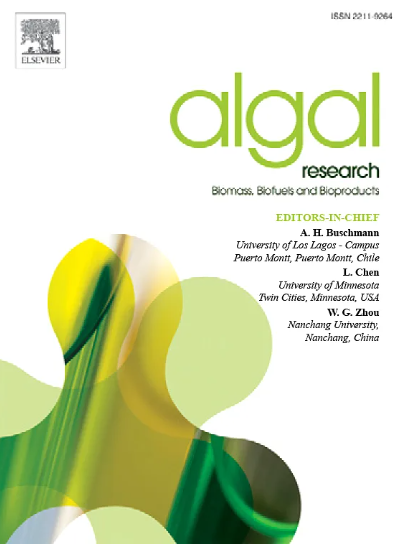水力滞留时间对高倍率藻池三级和四级处理影响的评价
IF 4.5
2区 生物学
Q1 BIOTECHNOLOGY & APPLIED MICROBIOLOGY
Algal Research-Biomass Biofuels and Bioproducts
Pub Date : 2025-07-28
DOI:10.1016/j.algal.2025.104239
引用次数: 0
摘要
研究了水力停留时间(HRT)对生物质沉降回用高速率藻池(HRAP)处理生活污水三级和四级处理性能的影响。HRT从4天(P1)减少到2天(P2),对氮(54.3±11.6和54.0±7.3%)、磷(42.6±21.6和39.3±35.8%)、有机碳(33.5±12.2和38.4±26.4%)和无机碳(55.6±10.8和50.5±26.8%)的去除率没有显著差异。出水中的大肠杆菌(分别为0.7±1.4和3.8±5.2 CFU-mL - 1)和悬浮固体(平均10 mg TSS-L - 1)浓度仍低于欧洲排放限值。然而,出水总氮(TN)浓度超过了这些限制,尽管有很高的NH4+去除率(>;95%)。对于CECs, P1中有9个化合物低于其定量限制,P2中有5个化合物低于其定量限制。HRT对CECs的总去除率影响较小,在P1和P2期间的去除率分别为57.6±4.0%和63.7±3.1%。生物量中保留的CEC浓度随着HRT的降低而增加,在P1和P2分别为723和1026 μg L−1。这些化合物大多属于氟喹诺酮类或消炎药。总的来说,hrap代表了一个具有成本效益的技术平台,用于生活废水的三级和四级处理。本文章由计算机程序翻译,如有差异,请以英文原文为准。
Assessment of the influence of the hydraulic retention time on the tertiary and quaternary treatment of a high rate algal pond
The influence of the hydraulic retention time (HRT) on the performance of a high-rate algal pond (HRAP) with biomass settling and recycling for tertiary and quaternary treatment of domestic wastewater was herein evaluated. A decrease in the HRT from 4 days (P1) to 2 days (P2) did not entail substantial differences in the removal efficiencies of nitrogen (54.3 ± 11.6 and 54.0 ± 7.3 %), phosphorous (42.6 ± 21.6 and 39.3 ± 35.8 %), organic carbon (33.5 ± 12.2 and 38.4 ± 26.4 %) and inorganic carbon (55.6 ± 10.8 and 50.5 ± 26.8 %). Escherichia coli (0.7 ± 1.4 and 3.8 ± 5.2 CFU-mL−1, respectively) and suspended solid (10 mg TSS-L−1 average) concentrations in the effluent remained below European discharge limits. However, the effluent total nitrogen (TN) concentration exceeded those limits, despite the high NH4+ removal capacity (> 95 %) of the HRAP. Regarding CECs, 9 compounds were removed below their quantification limit in P1, and 5 compounds in P2. The HRT exhibited a low impact on the total removal of CECs, with removal efficiencies of 57.6 ± 4.0 % and 63.7 ± 3.1 % during P1 and P2, respectively. The CEC concentrations retained in biomass increased at decreasing the HRT, with 723 and 1026 μg L−1 at P1 and P2, respectively. Most of these compounds belonged to the group of fluoroquinolones or anti-inflammatory drugs. Overall, HRAPs represent a cost-effective technology platform for tertiary and quaternary treatment of domestic wastewaters.
求助全文
通过发布文献求助,成功后即可免费获取论文全文。
去求助
来源期刊

Algal Research-Biomass Biofuels and Bioproducts
BIOTECHNOLOGY & APPLIED MICROBIOLOGY-
CiteScore
9.40
自引率
7.80%
发文量
332
期刊介绍:
Algal Research is an international phycology journal covering all areas of emerging technologies in algae biology, biomass production, cultivation, harvesting, extraction, bioproducts, biorefinery, engineering, and econometrics. Algae is defined to include cyanobacteria, microalgae, and protists and symbionts of interest in biotechnology. The journal publishes original research and reviews for the following scope: algal biology, including but not exclusive to: phylogeny, biodiversity, molecular traits, metabolic regulation, and genetic engineering, algal cultivation, e.g. phototrophic systems, heterotrophic systems, and mixotrophic systems, algal harvesting and extraction systems, biotechnology to convert algal biomass and components into biofuels and bioproducts, e.g., nutraceuticals, pharmaceuticals, animal feed, plastics, etc. algal products and their economic assessment
 求助内容:
求助内容: 应助结果提醒方式:
应助结果提醒方式:


